Mate
-
- Voices: Jill Zande, MATE II Marine Technology, Sep 2018 #24
Jill Zande, President and Executive Director at MATE Inspiration for Innovation (MATE II) was featured in last month’s MTR 100 as a top 10 ocean influencer. This month in MTR we present our full interview with Zande on the importance of attracting the next generation to a career in the oceans.
How did you come to a career at MATE?
As a research associate at the Dauphin Island Sea Lab (DISL), I thought that the only next step for me career-wise was to go back to graduate school, get a Ph.D., have a lab and take on graduate students. I saw the academic, Ph.D. path as my only realistic option; but I also knew down deep that it wasn’t for me. I started exploring the idea of making a career switch into marine education, which included looking at DISL’s Discovery Hall and the fantastic education programs it offers.Then my former major professor at Louisiana State University told me about MATE. He had just returned from Monterey where he participated in the MATE Forum, which was hosted at MBARI. This was a gathering of marine-related industry, academic, and government professionals and was designed to discuss and lay out the critical issues facing marine technical education. The focus was on technician education; providing students with practical, hands-on learning. I realized that was what was missing from my education – the hands-on, applied piece.
He also said that MATE was just getting started with funding from the National Science Foundation and was looking to hire people. I had always wanted to head to Monterey – who wouldn’t, with MBARI, the Aquarium, and the host of so many other marine-related institutions and organizations around the bay. I applied for the outreach program coordinator position and was hired, which was in August of 1998, so I’m just about to celebrate my 20th anniversary with MATE.
When you say MATE to most in this industry, the MATE robotics competition, I would argue, is the first thing to come to mind. Can you provide a history on your signature competition and its growth?
In the early days of MATE we conducted a number of workforce studies to help us identify the latest trends, occupations that needed well-educated and capable people, and “well-educated and capable” meant in terms of knowledge and skill sets. ROV technicians emerged as an occupation in need of skilled individuals.At the same time we were researching this, two synergistic things happened: we found the little yellow book (How to Build Your Own Underwater Robot and Other Wet Projects) and the Marine Technology Society ROV Committee came to us looking for help. They recognized the need for ROV technicians and how those currently applying for the positions didn’t seem to have the right skills. They also recognized the lack of awareness of the industry and its occupations; they gave the example that they had thousands of dollars of scholarships to give away, yet very few students were applying. They wanted to work with us to better connect with students, raise awareness of careers opportunities within the industry, and create a program that would encourage and help students to develop the necessary skills. So, literally, on the back of a napkin, the idea for the ROV competition was born. We needed someone to take the lead on this; I raised my hand.
MATE By the Numbers: Can you help provide size and shape to the organization and its impact in numbers?
The MATE competition is a labor of love. With only two full-time employees, some part-time help, and more than 1,600 volunteers, it showcases the amount of pride and passion that all those involved have for the program. Here at this year’s international, 100 volunteers including 16 alumni will be lending a hand, as will several parents of alumni. The event has become a family affair!It’s difficult to estimate the value of our volunteers’ time and technical expertise, but we gave it a try! Each year, all total, the competition benefits from more than $1 million in volunteer hours. Volunteers not only support MATE events as judges, some also run regional programs, organizing teacher and student workshops, outreach to students and putting together competition events.
Discuss this year’s ROV competition, and put in perspective how it has grown and evolved.
The MATE competition has grown significantly. It’s hard to believe that the MATE international competition was first held in 2002 with just 22 teams from 2 countries – those being the United States and Canada. Now there are 31 regional events that take place each year. And that number will only grow with the addition of a regional in Tennessee (and possibly elsewhere!) in 2019.For the 2018 competition season…starting in April, nearly 8,000 students representing 715 teams from across the country and around the world competed in regional events or submitted video demonstrations.
Nearly 800 students and 100 mentors qualified and participated in the international competition. 65 teams from 19 countries and 20 U.S. states tackled tasks that highlighted Jet City: Aircraft, Earthquakes, and Energy, which gave a nod to the location as this year’s competition theme.
The competition has certainly evolved over the years – and not just in terms of numbers. About five years ago we added a fourth competition level or class called NAVIGATOR (the progress is now SCOUT – NAVIGATOR – RANGER – EXPLORER).
Why was that done?
We did this because, in 2008, we recognized that middle schools were the fastest growing population of competition teams. We certainly hadn’t tried to proactively reach that population. As a matter of fact, our MATE grant focused on community colleges and linkages between high schools and 4-year-universities. But, with all of this interest, we recognized that we had an opportunity to make an impact at a level at which we tend to lose students in STEM. So, we went back to the National Science Foundation and got our first ITEST (Innovative Technology Experiences for Students and Teachers) grant. This provided us the resources to focus on teacher workshops, student outreach, curriculum, and ROV kits to specifically enable and support middle schools (and even elementary schools) to participate.Is that the only way it has evolved?
Another way that we’ve evolved is in our approach. We had always appreciated that the competition encouraged creative thinking, innovation, and the development of project management and teamwork skills. But back in 2011 we had a bit of sea change; we were very deliberate in requiring students to transform their teams into companies – to “think like entrepreneurs” – and structure themselves that way. Who would be their CEO? Who would be their CFO? Who would head up R&D? We wanted students to get an appreciation of business practices as well as how their specific roles fit into the bigger picture of a company structure.To keep in line with the business acumen, we laid out our mission scenarios as an RFP. The student-lead, mock companies were to respond to this RFP by designing and building an ROV that could meet the specified requirements. In addition to the ROV, other required “products” included technical documentation, an oral presentation and a marketing (poster) display.
Adding this business, entrepreneurial approach was a real game-changer. Teams enthusiastically embraced it, creating company tag lines, business cards, and even “dressing up” in suits for their engineering (oral) presentations. In addition, they sought out students in other disciplines and programs to help meet their “employment” needs; they pulled in accounting students to help manage the finances and budget, graphic design students to create company logos and marketing displays, and technical writers to help with formatting and organizing their technical reports. So, students from outside traditional STEM disciplines got involved, learned about ocean issues, and gained practical, hands-on experience. One student featured in our 2012 video said it best. When asked if he had any opportunities like this as an accounting major, he answered, “no, it’s all in the classroom, studying books…it’s fun to get out of the classroom and do something real-world…”
We often speak of grooming ‘the next generation.’ It seems that you have already answered this question, but in a phrase, how is MATE helping in this regard?
That’s what the MATE competition is all about! The competition challenges students to learn and creatively apply STEM skills to solve real-world problems in a way that strengthens their critical thinking, collaboration, entrepreneurship and innovation, and helps to prepare them for the workforce.The competition tasks K-12, community college, and university students from all over the world to tackle missions based on scenarios from the workplace. The competition’s class structure of beginner, beginner-intermediate, intermediate, and advanced complements the educational pipeline by providing students with the opportunity to build upon their skills as they engineer increasingly more complex ROVs for increasingly more complex mission tasks.
The MATE competition requires students to think of themselves as entrepreneurs and transform their teams into companies that manufacture, market and sell “products.” In addition to engineering their ROVs, the students prepare technical reports, poster displays, and presentations that are delivered to working professionals who serve as competition judges.The MATE competition encourages students to work together, network, and learn from technical professionals and each other. MATE’s philosophy is that collaborative learning experiences best simulate the real world and will serve students – and their future employers – well in the workplace.
From your time with the organization, of what are you most proud/from what do you get the greatest sense of satisfaction?
Each year I am amazed at the innovation and entrepreneurship of the student teams. They come up with some creative and sophisticated solutions. I think that the teams are equally as amazed at the variety of solutions that they see when they come to the event.What also gives me a great deal satisfaction is the support and dedication of our volunteers. We have people like Marty Klein, who has volunteered since the very beginning and travels each year, no matter where we are, to be a part of the international competition. We have working professionals who make the competition a regularly scheduled part of their year, building their vacation around it and, in some cases, paying out of their own pocket to get there. We also have professionals who each year judge the teams’ technical reports yet never have the opportunity to attend the competition and meet these teams in person.
And I have to say it is so rewarding (and humbling) to look out over the sea of students, teachers, mentors, parents, and volunteers during the opening and closing award ceremonies. To see how the competition has grown and brought together such a diversity of people and cultures, built a global community of learners, inspired career paths, opened up opportunities, and changed lives.
As it says in that 2017 international competition video, “it’s where the product being developed is just as much the person as the ROV.”
I’m honored to play a small part in helping to “groom the next generation” and inspire and motivate brilliant young minds to tackle these challenges.
Looking ahead, what is your biggest challenge?
I used to say managing the explosive growth (we went from 1 regional in 2002 to 31 in 2018), but now I say funding! Especially as we make the transition from a grant-funded center to a non-profit with a diverse – and hopefully growing – revenue stream.You may know that the MATE Center was established with funds from the National Science Foundation (NSF), and continues to receive funds from NSF today. The Center has been around since 1997 as part of Monterey Peninsula College (MPC) in Monterey, Calif.
We recently launched MATE Inspiration for Innovation or MATE II, a 501(c)(3) non-profit organization that was created to support the competition. MATE II’s goal is to give the competition a life beyond federal grant funding and allow the program to continue well into the future. We want to keep the competition going and the dream alive for students who are “inspired to innovate” and tackle the challenges that our global community is facing today – and tomorrow.
MATE II has an MOU in place with MPC, so our address hasn’t changed – and my office hasn’t gotten any bigger. We have a fantastic and very active Board of Directors that includes Justin Manley, Fritz Stahr, and Debbi Kill along with the MATE Center PI Deidre Sullivan. I’m excited about this “new chapter” in my career and where it will take us with the long-term sustainability of the MATE competition. I look forward to continuing to work with the marine technology community – and beyond – to keep the competition going and growing and continuing to have a positive and life-changing impact on students and on the future global workforce.
-
- Subsea Processing Boosting and Gas Compression Marine Technology, Apr 2014 #28
by allowing smaller intervention vessels, which are more readily available than high payload deployment vessels and less costly to operate. Wet-Mate Connectors Enable Modularity A wet-mate connector is a device that allows connection of electrical conductors together. Connectors are designed for
-
- Future ROV Designers Marine Technology, Jul 2013 #66
Underwater ROV Competition. Their teamwork and intensity belies their tender years. This is the 12th year the Marine Advanced Technology Education (MATE) Center at Monterey Peninsula College has held the competition. Their goal in doing so is to increase awareness of marine technical fields and careers
-
- MTR 100: Teledyne Marine Interconnect Solutions Marine Technology, Jul 2014 #82
options from terrestrial and topside applications to littoral and deep ocean environments. Applications include demanding explosion proof systems, dry-mate submersible instrument and vehicle harnesses, high differential pressure penetrations, and connections to wet-mate electrical and hybrid jumpers for
-
- SAFETY: Distractions Can Sink Careers Marine News, May 2019 #30
came together on the bridge of a towboat traveling downriver to pick up a load of empty barges, the result was career-changing for the vessel’s first mate, who was on the wheel. It was yet another costly reminder of the need for professional mariners to give their often dangerous jobs their undivided attention
-
- Night Moves on America's Waterways Marine News, Nov 2014 #32
at an oil terminal downriver. The weather was mostly clear under a crescent moon with patchy fog and little wind as the tugboat got underway. The vessel’s mate who was on watch had recently ended a heated argument with a family member on his radio telephone and was resuming his regular duties. Perhaps because
-
- MTR100 '13: Teledyne Impulse, Teledyne DGO & Teledyne ODI Marine Technology, Jul 2013 #48
applications where they are required to function flawlessly under any expected operational conditions. Solutions for these harsh environments include wet-mate and dry-mate connectors, pressure boundary penetrators, cable assemblies, and high power systems. Teledyne Marine Interconnect Solutions is a unique
-
- MTR100: Teledyne Oil & Gas (PART II) Marine Technology, Aug 2015 #42
, all have to be interconnected. Large modular pieces of equipment are placed across a wide area on the seafloor. We provide harsh environment wet mate and dry mate interconnect solutions that allow electrical power and electro-optical data transmission between these modules, providing the functionality
-
- MTR’s “Top 10” Ocean Influencers Marine Technology, Jun 2018 #6
money and influence for the betterment of the world and humanity, and through his company Vulcan Inc., Allen is working to save endangered species, slow climate change, improve ocean health, share art, history and film, develop new technology, tackle epidemics, research how the human brain works and build sustainable
-
- Moss Point Marine Launches First Of Two Utility Boats For Argosy Maritime Reporter, May 15, 1984 #15
Moss Point Marine recently launched the first of two 140-foot by 32-foot by 11-foot utility boats for Argosy Offshore, Ltd., of Lafayette, La. The Argosy Mate will be joined in the very near future by the Argosy Chief. These two vessels will complete a five-boat package for Argosy by Moss Point Marine
-
- Seacon Expands Connector Range Marine Technology, Apr 2014 #58
safe disconnection of connectors to be used in these environments SEA CON has developed a new robust range of Exd connectors due to be released soon. The EX-MATE is based around SEA CON’s existing and successful SEA-MATE connector range and is fully wet-mateable in addition to its suitability for use in explosive
-
- The First Voyage of the S.S. Michael Moran Maritime Reporter, Aug 2004 #36
shipyard in Portland. Me. where she was built. She was operated by Moore McCormack Lines, a company with whom I had sailed before. I signed on as Third Mate; this would be my fourth Liberty Ship. From Portland we sailed down to Boston where we loaded military cargo for a destination unknown. Most of
-
 )
March 2024 - Marine Technology Reporter page: 44
)
March 2024 - Marine Technology Reporter page: 44NEW TECH OCEANOLOGY INTERNATIONAL 2024 Image courtesy Metron/Cellula Teledyne Marine acquires Valeport: Matt Quartley, MD, Valeport and Ole Søe-Pedersen, VP & Image courtesy Teledyne Marine GM Teledyne Marine announce the deal in London. Pictured (L-R): Cellula Robotics, President, Eric Jackson, Metron
-
 )
March 2024 - Marine Technology Reporter page: 42
)
March 2024 - Marine Technology Reporter page: 42, and the launch of a new high amperage subsea connector se- ries, the 225 Amp BIRNS Meridian line. The Meridian line, a robust, custom engineered dry-mate connector series is open face rated to 6km, and is well-suited for battery packs and thrusters for crewed and uncrewed subsea vehicles that re- quire
-
 )
March 2024 - Marine Technology Reporter page: 16
)
March 2024 - Marine Technology Reporter page: 16act like a battery in seawater, • Assessment of risk associated with the identi? ed threats, creating a current that causes consumption of the anode mate- • Inspection, testing and maintenance planning, rial. The practice signi? cantly extends the lifespan of under- • Inspection, monitoring and testing
-
 )
April 2024 - Maritime Reporter and Engineering News page: 41
)
April 2024 - Maritime Reporter and Engineering News page: 41| email: [email protected] CEO and co-founder, Groke Technologies nologies: Mitsubishi Corporation, Japan’s Asia and Europe. with professional development mate- largest trading house and a partner since It takes less than a day to install the sys- rial, helping them apply lessons learned our founding in 2019
-
 )
April 2024 - Maritime Reporter and Engineering News page: 25
)
April 2024 - Maritime Reporter and Engineering News page: 25old ships while trying Today, if we have to move forc- to recapitalize the ? eet? es--with their vehicles, equipment To start, we are building new and material--from the U.S. to where ships. Over the next decade, 12 new it’s needed, most of that will move by classes of ships will come online and sea
-
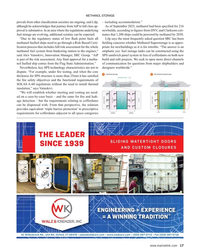 )
February 2024 - Maritime Reporter and Engineering News page: 17
)
February 2024 - Maritime Reporter and Engineering News page: 17the regulations underlying newbuilds, according to ? gures from DNV, and Clarksons esti- fuel storage are evolving, additional scrutiny can be expected. mates that 1,200 ships could be powered by methanol by 2030. “Due to the regulatory status of low ? ash point fuels all Lilp says the most frequently
-
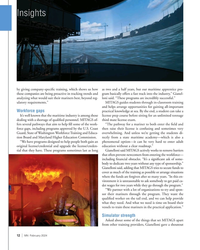 )
February 2024 - Marine News page: 12
)
February 2024 - Marine News page: 12industry is among those license prep course before sitting for an unlimited tonnage dealing with a shortage of quali? ed personnel. MITAGS of- third mate license exam. fers several pathways that aim to help ? ll some of the work- “The pathway for a mariner to both enter the ? eld and force gaps, including
-
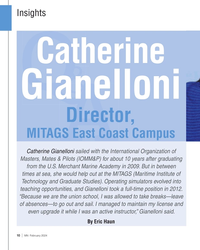 )
February 2024 - Marine News page: 10
)
February 2024 - Marine News page: 10QQQQQQQQQAAA & Gianelloni Director, MITAGS East Coast Campus Catherine Gianelloni sailed with the International Organization of Masters, Mates & Pilots (IOMM&P) for about 10 years after graduating from the U.S. Merchant Marine Academy in 2009. But in between times at sea, she would help
-
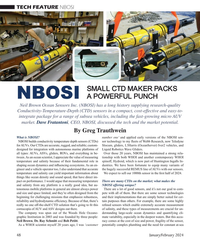 )
January 2024 - Marine Technology Reporter page: 48
)
January 2024 - Marine Technology Reporter page: 48spun out of the Woods Hole Oceano- derstanding large-scale ocean dynamics and quantifying cli- graphic Institution in 2003 and was founded by three people: mate variability, especially in the deepest waters. But this accu- Neil Brown, Dr. Ray Schmitt and Bob Petitt. racy comes at the cost of size and power
-
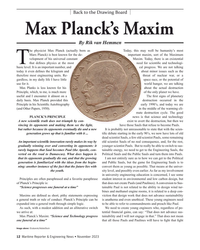 )
November 2023 - Maritime Reporter and Engineering News page: 12
)
November 2023 - Maritime Reporter and Engineering News page: 12occurred in the Principle in his Scienti? c Autobiography early 1990’s, and today we are (and Other Papers, 1950). in the middle of the warming cli- mate destruction cycle. The good PLANCK’S PRINCIPLE news is that science and technology A new scienti? c truth does not triumph by con- exist to avert
-
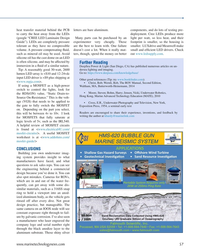 )
September 2023 - Marine Technology Reporter page: 57
)
September 2023 - Marine Technology Reporter page: 57heat transfer material behind the PCB letters are bare aluminum. components, and do lots of testing pre- to carry the heat away from the LEDs deployment. Cree LEDs produce more (google “CREE LED Luminaire Design Many parts can be purchased by an light per watt, so less heat, and their Guide”). LEDs
-
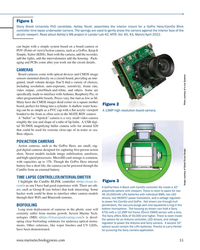 )
September 2023 - Marine Technology Reporter page: 55
)
September 2023 - Marine Technology Reporter page: 55water hous- ing can be as simple as a PVC cap with a ? at acrylic viewport A 13MP high resolution board camera. bonded to the front as often seen in the MATE ROV contest. A “bullet” or “lipstick” camera is a very small video camera roughly the size and shape of a tube of lip balm. A USB digi- tal 50-500X
-
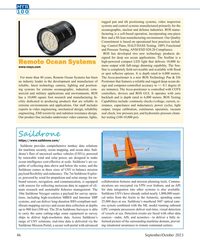 )
September 2023 - Marine Technology Reporter page: 46
)
September 2023 - Marine Technology Reporter page: 46and mission planning tools. Commu- with sensors for collecting metocean data in support of cli- nications are encrypted via VPN over Iridium, and an API mate research and sustainable ? sheries management. The for data integration into other systems is also available. 10m Saildrone Voyager carries a payload
-
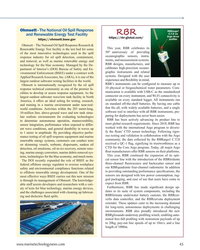 )
September 2023 - Marine Technology Reporter page: 45
)
September 2023 - Marine Technology Reporter page: 45long-term, autonomous deployments in challenging environments. RBR also proudly introduced the new RBRglissando underway pro? ling winch, enabling auto- mated free-fall pro? ling with instrument payloads of up to 20kg, pay-out line speeds of up to 10m/s, and a line length of 1000m. www.marinetechnologynews
-
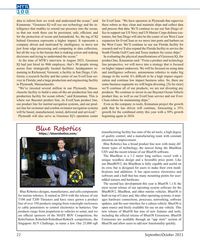 )
September 2023 - Marine Technology Reporter page: 22
)
September 2023 - Marine Technology Reporter page: 22. This products range from propulsion to vehicles to sonar, and we new release of BlueOS has tens of new features and tools, are of? cial sponsors of the MATE ROV Competition, the including the of? cial release of BlueOS Extensions. BlueOS RoboNation RoboSub/RoboBoat/RobotX competitions, the Extensions
-
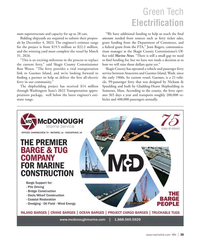 )
October 2023 - Marine News page: 39
)
October 2023 - Marine News page: 39Bidding shipyards are required to submit their propos- amount needed from sources such as ferry ticket sales, als by December 4, 2023. The engineer’s estimate range grant funding from the Department of Commerce, and for the project is from $19.5 million to $22.2 million, a federal grant from the FTA,” Jenn
-
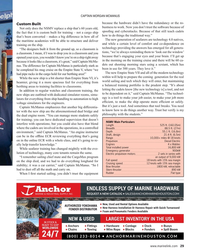 )
September 2023 - Maritime Reporter and Engineering News page: 29
)
September 2023 - Maritime Reporter and Engineering News page: 29of technology, many core tenants remain the same. Electric propulsion motors 2 sets in series with an output of 9,000 kW “I remember sailing chief mate and the CargoMax program Full speed 18 knots with 15% sea margin on the ship died, and we had to do everything longhand for Cruising speed 12 knots
-
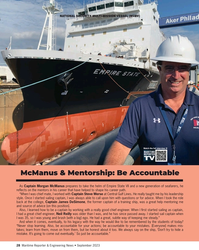 )
September 2023 - Maritime Reporter and Engineering News page: 28
)
September 2023 - Maritime Reporter and Engineering News page: 28Empire State VII and a new generation of seafarers, he re? ects on the mentors in his career that have helped to shape his career path. “When I was chief mate, I worked with Captain Steve Werse at Central Gulf Lines. He really taught me by his leadership style. Once I started sailing captain, I was always
-
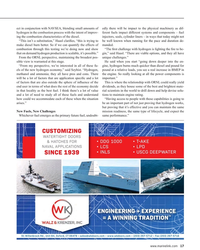 )
September 2023 - Maritime Reporter and Engineering News page: 17
)
September 2023 - Maritime Reporter and Engineering News page: 17with ORNL could really yield end user in terms of what does the rest of the economy decide dividends, as they house some of the best and brightest mate- in that locality as the best fuel. I think there’s a lot of value rial scientists in the world to drill down and help devise solu- and a lot of need
-
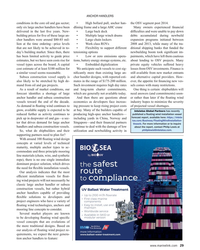 )
August 2023 - Maritime Reporter and Engineering News page: 29
)
August 2023 - Maritime Reporter and Engineering News page: 29boom took signi? cant im- has been limited activity to guide price • Low or zero emissions opera- pairments, which have left them cautious estimates, but we have seen costs rise for tions, battery energy storage systems, etc. about lending to OSV projects. Many vessel types across the board.
-
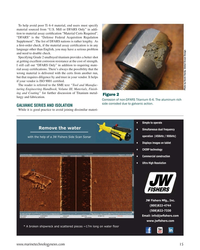 )
July 2023 - Marine Technology Reporter page: 15
)
July 2023 - Marine Technology Reporter page: 15To help avoid poor Ti 6-4 material, end users must specify material sourced from “U.S. Mill or DFARS Only” in addi- tion to material assay certi? cation “Material Certs Required”. “DFARS” is the “Defense Federal Acquisition Regulation Supplement”. The list of DFARS nations is rather lengthy. As a ?
-
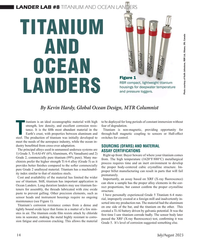 )
July 2023 - Marine Technology Reporter page: 14
)
July 2023 - Marine Technology Reporter page: 14LANDERS Photo courtesy of Keith Johnstone, RBR Ltd, Ottawa, ON, Canada By Kevin Hardy, Global Ocean Design, MTR Columnist itanium is an ideal oceanographic material with high to be deployed for long periods of constant immersion without strength, low density, and excellent corrosion resis- fear of degradation
-
 )
May 2023 - Marine Technology Reporter page: 42
)
May 2023 - Marine Technology Reporter page: 42It’s now been several months since the contract components to allow for such ? exibility. SUTAs utilize wet- was awarded. Can you give us an update on the mate connector technology and advanced ? ber termination as- status of the project? semblies to allow for direct connections to be made undersea As of
-
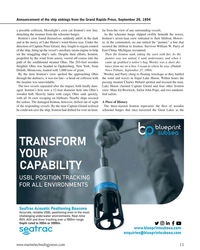 )
March 2023 - Marine Technology Reporter page: 13
)
March 2023 - Marine Technology Reporter page: 13the impact, both fatally dam- Lake Huron claimed Captain Girard and four other Ironton aged. Ironton’s bow tore a 12-foot diameter hole into Ohio’s crew: Mate Ed Bostwick, Sailor John Pope, and two unidenti- wooden hull. Heavily laden with cargo, Ohio sank quickly, ? ed sailors. with all 16 crew escaping
